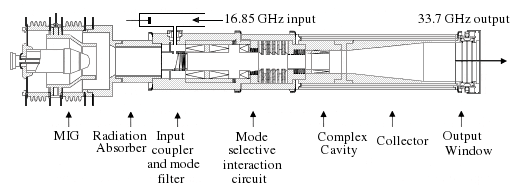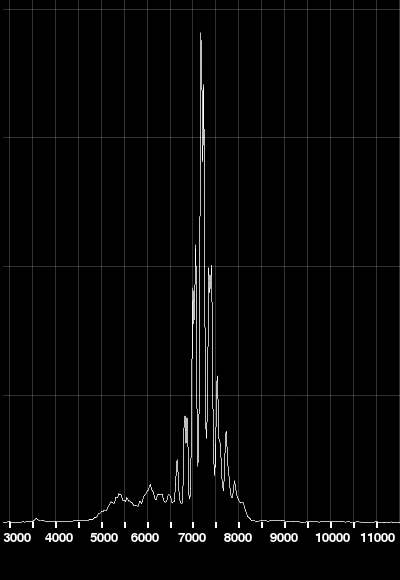 hy would the US government be so certain that a ‘sonic weapon’ is being
used against our diplomats in Cuba, yet be so unwilling to give details? One possible
reason might be that they've learned about a principle for such a weapon and are
reluctant to make information about it public. There could, for example, be some unusual
form of modulation of ultrasound that could have the effects we're hearing about:
buzzing cricket-like sounds, hearing damage, and brain injury.
hy would the US government be so certain that a ‘sonic weapon’ is being
used against our diplomats in Cuba, yet be so unwilling to give details? One possible
reason might be that they've learned about a principle for such a weapon and are
reluctant to make information about it public. There could, for example, be some unusual
form of modulation of ultrasound that could have the effects we're hearing about:
buzzing cricket-like sounds, hearing damage, and brain injury.
But it seems unlikely: in order to cause injury efficiently, sound has to be at a frequency that can cause resonance. That means it has to have a wavelength comparable to the structure that's being affected. The lowest audible frequency, 20 Hz, has a wavelength of 54 feet. The highest frequency, 20 kHz, is 0.65 inches. So most of the dimensions that can produce interesting effects in the brain would be in the audible range.[9] Passers-by would have noticed that.
(continued below)

Diagram of a ten-beam microwave gyrotron invented at Stanford. This is called a gigawatt multiple-beam klystron or GMBK. It was an early approach to generating high power microwaves. The inside needed a high vacuum to work, and the L-band microwaves come out of the right side. What these devices all have in common is that they use a lot of electricity. The device is 58.5 inches long. (Source: ref. [3], page 462)
Despite extravagant claims on some other websites, infrasound and ultrasound have other problems besides wavelength mismatch (described here) that make them difficult to use as weapons. They just don't propagate through air well enough, and any well constructed and insulated building would provide significant attenuation of such sound beams.
But there is something that can produce exactly what the news media are describing: a MEDUSA weapon. MEDUSA, or Mob Excess Deterrent Using Silent Audio, uses the microwave auditory effect to create sound that appears to originate inside the victim's head. Unlike sound waves, it can't be blocked by walls, unless they're metallic.
New Atlas says the microwave auditory effect works like so:
[M]icrowave stimulation causes parts of the ear around the cochlea to expand thermally, which is interpreted as sound by the brain. The effect is a sound that appears to originate in the target's head, and can't be heard by anyone not directly in the beam's path.
New Scientist magazine quoted James Lin of the Electrical and Computer Engineering Department at the University of Illinois in Chicago as saying that high power microwaves could create potentially hazardous shockwaves. Unlike normal sound waves, you couldn't block them out. A microwave beam can be tightly focused and would be tough to find, as it could be anywhere within line of sight of the target.
Unlike these deadly infrasonic brown note ghetto blasters we keep hearing about, the microwave auditory effect is a real phenomenon. There are a number of papers on it in the open literature. Elder and Chou[1] say “The sound is similar to other common sounds such as a click, buzz, hiss, knock, or chirp.” Ingalls[5] said it sounded like “a bee buzzing on a window”. The sound appears to originate from within, behind, or above the head. This is exactly what some of the victims describe. The buzzing sound arises from the fact that these radars had pulse repetition rates above 100/sec.
How much RF energy would be required to produce such an effect? The effect depends on the energy in a single pulse, and not the average power density, which is consistent with the technology of high power microwaves, which are usually produced in short, high intensity pulses. People can hear radar at peak power densities as low as 90 milliwatts per square centimeter[1]. RF between 2.4 MHz and 10 GHz can produce sounds if the victim's hearing is good enough over 5 kHz, which is true for most people. Earplugs have no effect.
Masers don't seem to be up to the task—they're usually used in ultra-low noise RF amplifiers. (A report from 1994 reported an 8440 MHz amplifier with a noise factor of 1.43 ± 0.16K. That's a remarkable 0.021 decibels).
Barker and Schamiloglu[3] say that in the 1990s the US Navy was experimenting with relativistic klystrons that produce 90 ns pulses with over 10 GW of peak power. They say that most of these military programs were shut down in the late 90s due to budgetary constraints; the RF sources were described as “large“, i.e. over 1000 lb, but some were said to weigh only 4.4 pounds.

Diagram of a phigtron[6], a Ka-band phase coherent harmonic multiplying inverted gyro-twystron, invented in 1993. A magnetron injection gun (left) generates an electron beam and the microwaves, which come in from the top, are amplified and frequency-multiplied. Essentially it is a gigantic traveling wave tube (TWT) amplifier. These suckers weigh about 1000 pounds and produce 200 kW of microwaves at 33.75 GHz (8.9 mm) with about 40% efficiency. (Source: [3,6])
What kind of antenna would they use? In his book Electronic Warfare in the Information Age, Curtis Schleher talks mostly about 3 meter diameter parabolic dishes. One of the problems in high-power microwave devices is reflected energy, but you'd probably get almost as good a result with a waveguide and a small horn-type antenna. The main limitation of small antennas is the dielectric strength of air, which limits the amount of energy that can be emitted to about 100,000 Joules per 1 μsec pulse through a 3m antenna. A 10 m antenna could emit about a million Joules per pulse,[4] enough to put a tomato in orbit. A microwave oven this powerful could bake a potato in 250 billionths of a second.*

Warning high power microwaves sign
Radio waves don't cause brain injury by themselves; their main effect is to cause heating. The pressure at the RF hearing threshold is about 1,000,000 times (60 dB) lower than the pressure that causes moderate brain damage. It should also be noted that people are not injured by RF from MRI scanners, which produce pulsed RF, and that the current trend in military radars is for lower power. Terahertz radiation is another matter, and its health effects are not well understood. But other researchers found that a single RF pulse of 680 J, about 36,000 times (45.56 dB) higher than the threshold for RF hearing, could produce an 8° increase in brain temperature which caused grand mal seizures and unconsciousness in rats, leading to brain swelling a month after exposure. Researchers were also surprised to discover that even relatively moderate microwave exposure (14–42 W/kg for 30 min) could be lethal to (anesthetized) rabbits [2].

Purported spectrum of sound at US embassy.
If I were the US State Department, I'd forget about acoustic weapons and start listening for high power microwaves and look for the big honking power cables they would need. Or maybe they could ask around to see if anyone ever noticed anything that resembled, say, a thirty-foot radar dish pointing at them.
Update (oct 13, 2017): A recording of the sound has been released to the news media. They don't say much about it. A spectrum is shown at right. It shows a number of peaks between 5 and 8 kHz. There is no energy between 8.5 kHz and 23 kHz, which is the limit of my sound card. I'm still looking for an actual sound recording that can be analyzed properly; so far, all that exists is YouTube videos. For all we know, the harmful frequencies, if there are any, could have been filtered out of the recording.
The noise does sound like the “bee buzzing on a window” described above, but even if this was an actual recording captured by a microphone, it doesn't necessarily rule out microwaves as a source: microwave sound is just thermally generated sound (examples: [7,8]). The answer depends on the details of how it was recorded. A glass of water, or physical nonlinearity in a microphone, might be enough. (One person emailed me suggesting that electronic nonlinearity, which causes rectification, might also work. Most people have probably heard buzzing sounds coming from their computer sound cards produced by the digital RF signal from nearby cell phones; that's an example of a nonlinear effect.)
Sounds created by pulsed radar superficially resemble some aspects of this spectrum. They all produce a series of evenly spaced spikes in the FFT; some have a maximum centered at 7–8 kHz. However, when I ran a couple of quick simulations modeling RF-induced thermoacoustic sound, I couldn't find any standard radar waveforms that produced such a narrow envelope. Even getting close required adding distortions and reflections to the RF signal. If the Cubans are using radar, their transmitter is seriously out of whack.
This noise would definitely be annoying, but it's hard to believe this sound could cause brain injury. It's even harder to believe it could get through the thick glass in a commercial building like our embassy in sufficient intensity to cause hearing loss. But who knows.
Update (sep 02, 2018): I just realized that pulse-coded radar can produce a spectrum very similar to what was observed in Cuba. See here for details.
* A joule is a unit of energy equal to one watt-second. One online encyclopedia says one Joule is enough to raise 1 gram of water by 0.24° C, or the energy required to raise a 100 g tomato by about three feet above the Earth's surface.
1. Elder JA, Chou CK. (2003) Auditory response to pulsed radiofrequency energy. Bioelectromagnetics. Suppl 6:S162–173. Abstract
2. Elder JA. (2003). Ocular effects of radiofrequency energy. Bioelectromagnetics. Suppl 6:S148–161. Abstract
3. Barker RJ, Schamiloglu E, eds. (2001). High-Power Microwave Sources and Technologies. IEEE Press, NJ, p. 15.
4. Schleher DC (1999). Electronic Warfare in the Information Age. Artech House, Norwood MA, p. 484.
5. Ingalls CE. (1967). Sensation of hearing in electromagnetic fields. NY State J Med 67:2992–2997. (cited in [1]).
6. Grantstein VL, Guo H, Carmel Y (1993). Improved design concepts for millimeter wave power sources. AFOSR progress report. PDF file
7. Tao LQ, Liu Y, Ju ZY, Tian H, Xie QY, Yang Y, Ren TL. (2016). A Flexible 360-Degree Thermal Sound Source Based on Laser Induced Graphene. Nanomaterials (Basel). 7;6(6). pii: E112. doi: 10.3390/nano6060112. Abstract
8. Wen L, Yang S, Zhong J, Zhou Q, Xing D. (2017). Thermoacoustic Imaging and Therapy Guidance based on Ultra-short Pulsed Microwave Pumped Thermoelastic Effect Induced with Superparamagnetic Iron Oxide Nanoparticles. Theranostics. 7(7):1976–1989. doi: 10.7150/thno.17846. Link
9. The speed of sound in tissue is about 1540 meters/second, slightly faster than in water (1480 m/s) and 4.5 times faster than in air, so a 7 kHz sound wave would have a wavelength of 8.66 inches in tissue.
created oct 05, 2017, 5:55 am; edited oct 05 2017, 7:25 pm; second figure added oct 07, 2017, 6:25 am. Updated oct 13, 2017, 7:30 am. Last edited sep 05 2018, 5:02 am
